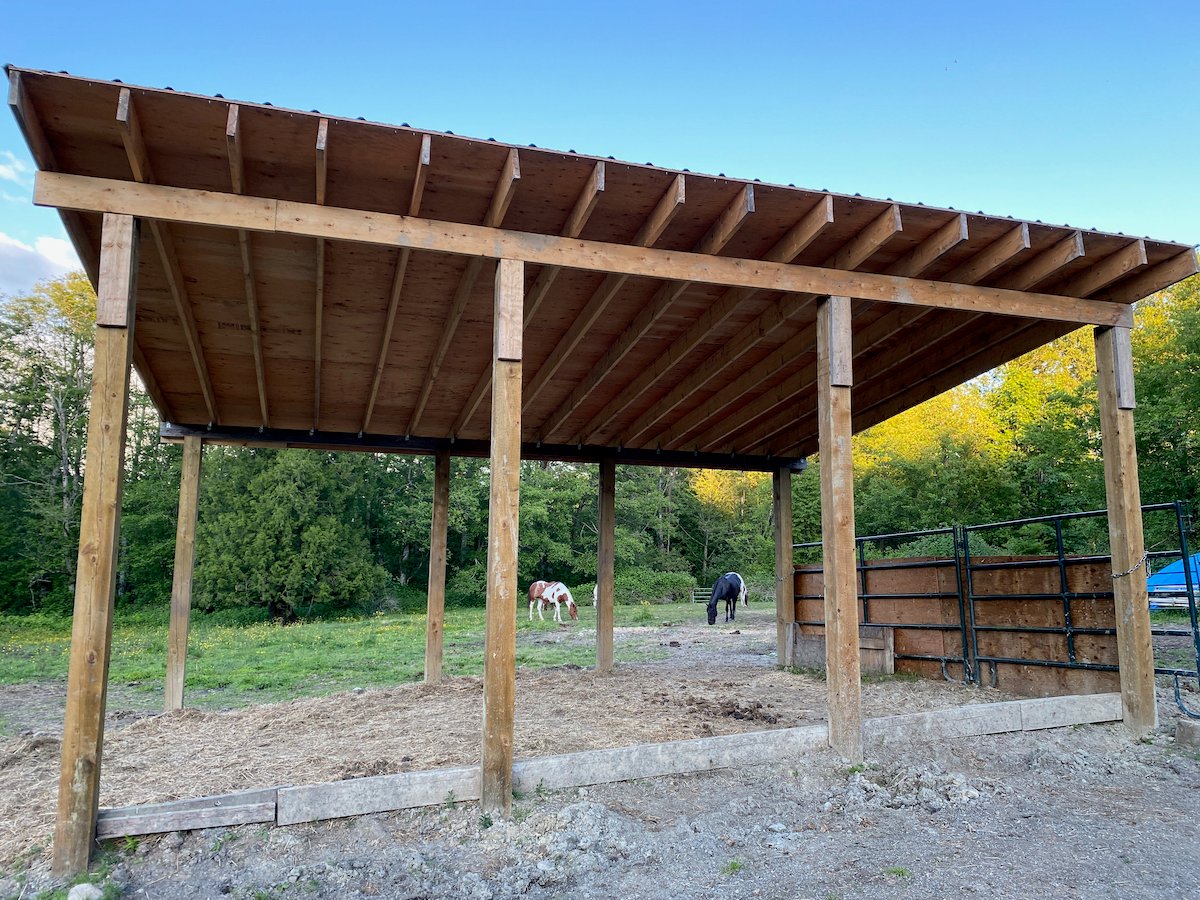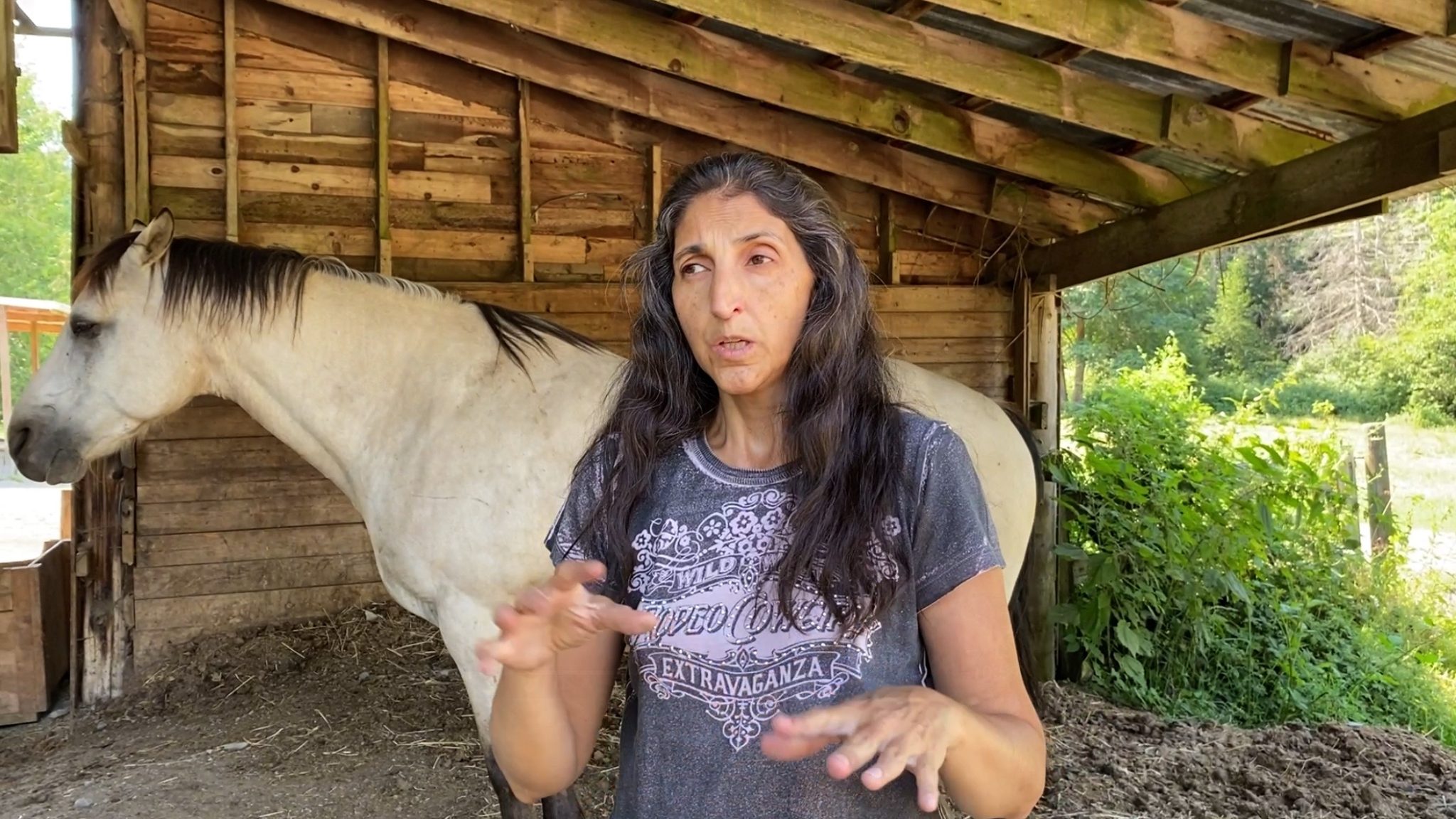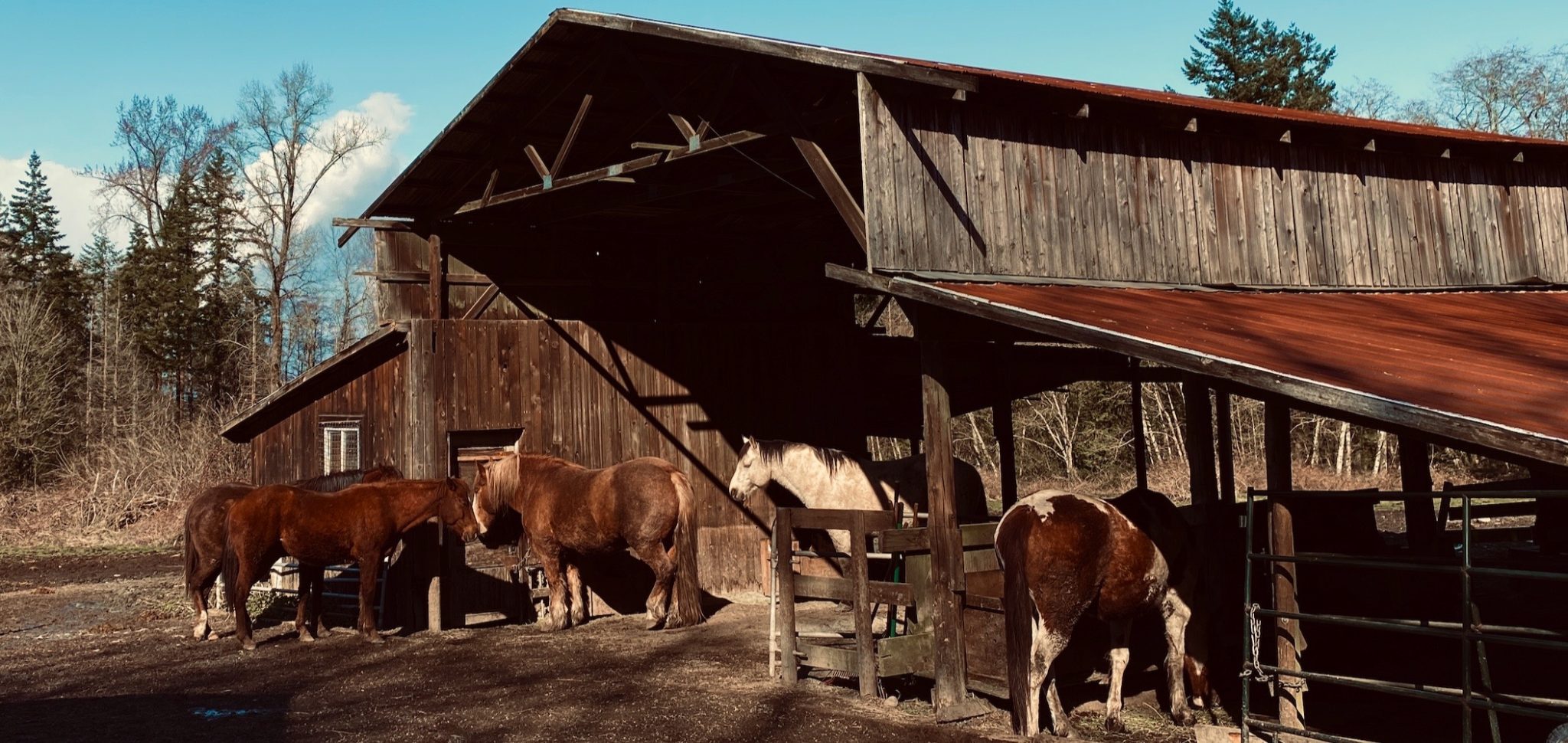Having been on numerous properties with my herd of up to 11 horses, I have noticed a few elements in barn or shelter design that result in a space that horses enjoy AND that provide protection from horseflies, while keeping cool in summer – but not too cold in winter! Let me share what I’ve learned…
Firstly, I had a bias that a big, airy shelter like this pole barn would be ideal for horses, because it would allow for the maximum amount of airflow:
But as you can see from this photo, I had to add a “wall” to one side for the winter because the wind blew cold air and also blew lots of rain into the shelter from this South end. In the summer, the ceiling height allowed lots of air to circulate, but this design does nothing to minimize horse flies.
My 80×200′ pole barn at my ranch near Vernon, BC, with it’s 24-foot roof, also does nothing to deter horse flies, although it is cool, with both plenty of shade and wind blowing through it. The horses love to sleep and shelter here during the hottest parts of the day, as long as the horse flies are not attacking:
For some reason, this is the shelter at the ranch that provides the most protection from those carnivorous horse flies. This structure is actually part of the original homestead on this ranch:
Note that it is enclosed on 3 sides, with a decently high roof and then a good-sized east-facing window for airflow. I have seen numerous horses bolt for this shelter when being harassed by horse flies.
This preferred ranch shelter above, is very similar to another barn at a property we boarded at – same 3 walls, with a window. But the window was smaller, south-facing and the open side was north-facing, so this shelter did not get nearly as much airflow:
Now, if you have the money or resources to build whatever you want, this next barn is ideal. Because it combines all the successful elements into one structure, so the horses can choose where they want to be, depending on the weather, bugs, wind, etc. I’m going to tell you exactly why this barn design is so brilliant:
I never knew before we boarded at this property how amazingly cool a barn with a high roof is! I don’t know exactly when this barn was built, but it would have been at least 40 years ago. This barn design has a central super high roof area (24 feet), and then two wings off either side; the roof on the North wing is 10 feet high and open on 3 sides, and the roof on the South wing is 8 feet high, sloping down to only 5 feet high (this side is where the wind blows the hardest – so it has the shortest roof and then the whole South side is boarded up, except for a gap at the top for airflow). When this was a cow barn, the feeders ran along the whole length of this South section, east to west.
This is what the North wing looks like – there is only a wall on one side (the other 3 sides are open) and this is their preferred spot to sleep during winter. This roof slopes from 10 feet down to about 8 feet:
The other fabulous thing about having a central area with a high roof, is you can host plenty of beneficial wasps (who will hugely reduce your fly and mosquito population), yet their nests will be well out of the way so they can happily co-exist with humans. Here’s my video on the mutually beneficial relationship we can have with wasps and hornets:
Although the south wing of this barn, where the cows were fed, slopes down incredibly low for a horse, not only have I not seen any of my horses whack their head on the ceiling, but this is their favorite meditation spot in summer. In addition, this is the best spot to escape those biting horse flies and a nice breeze always blows in from the east. Perhaps horse flies don’t like enclosed, darker structures? AND a quick search turned up this confirmation from Wikipedia:
“They prefer to fly in sunlight, avoiding dark and shady areas, and are inactive at night.”
So there you go, the best protection from horseflies is going to be a cool, yet darker, shaded structure.
This old barn is the coolest barn in summer, yet waterproof, windproof and warm in winter. I have two other pole barn shelters at this property (see pic below), but the horses will always choose the sloped roof cow shed in summer and the main big barn area in fall, spring and winter.
Don’t get me wrong, they will often eat from the slow feeders in these paddock shelters, and they really love the variety of options, which give them reasons to move around frequently (movement = exercise!). But if they’re choosing somewhere to lie down, it’s the North wing, and to meditate, it’s either the central area or the South wing of the big barn.
In case you missed it, here’s my video where I take you on a guided tour of my permaculture set-up at this property, where we boarded for 5 years:
So based on my experience, if you’re going to build a barn:
1. Determine which direction you get the most wind blowing during winter, because that’s the side you’ll need walls. But as per the South wing of my big barn, it may still be a good idea to leave a 6″ gap for airflow.
2. Does your wind tend to blow from a different direction during the summer? At our Langley property, the wind blew the strongest from the South during the winter. But during summer, we always had a nice breeze blowing from the East.
3. When you’ve determined where your wind blows from during the summer, plan your barn so that you can have a darker, 8-foot roof or lower, shaded area to deter horse flies – but make sure there’s a decent-sized window to let the wind in.
4. Make sure you have a section or area that’s open on at least two sides, with a really high roof (20-foot or higher is ideal) to provide cool shade and ideal wasp and owl habitats. Put an owl house up in the roof of this section if you can. Wasps will keep fly and mosquito populations down and owls will control rats, gophers, mice, etc.
If you’ve got a barn or shelter that works well for your horses, please post a picture below and tell us what works (and doesn’t work so well) – and be sure and let us know which direction you get the most wind blowing from 🙂

Jini Patel Thompson is a natural health writer and Lazer Tapping instructor. She began riding at age 2 in Kenya, and got her first horse at age 8 in Alberta, and so continues a life-long journey and love affair with these amazing creatures.



















Awesome article, will reference when I am setting up my horse property, thanks Jini! 🙏
Perfect Penny!
I think climate plays a big role in any structure. As you know here in our part of California it’s very hot! We also get some extreme winds during the winter at times…we have clocked over 50mph a few times 😵💫
We built this combo shelter tack room hay shed when we first moved here and we were very fortunate that it has worked so well and protects so well in the extreme heat and in the winter. Although the horses rarely use it in the winter because they prefer to stay out in the open or use the slopes of the land to lesson the affects of the weather. We also don’t get any snow. The only unfortunate thing is the oak trees behind the shelter in the extreme wind! They offer so much help in the summer heat with adding another layer of sun blocking to the shelter but in the winter storms they drop acorns and branches on the tin roof and at certain times (not all the time) it can scare the horses right out of the shelter. We also set it up to be as open as possible with the option to put a few railing boards on and it turns into a three horse stall shelter. We use this for yearly dental appointments. We have also made it into a two open stall with horse panel run added on for Dreamer when he foundered and could not be on any green grazing. It’s very versatile and I love it. My husband built it very high so I could hang sticky fly tapes to help with flies and it also has lots of wasps nests although not any this year…just like you? I also asked he leave a small gap at the back for even better air flow. The flies in the shelter are almost nil and the horses seem to enjoy that a lot🤩 In our heat the flies are not horrible and I also do a lot to try and keep them to a minimum like daily poop pick , fly strips and openly welcome any wasps. Here is a picture of our set up! Yes my husband is incredible!
✌🏼💚🐴
Here’s a picture of Michelle’s shelter:
I can see how the acorns and branches from the oak trees could scare the horses – BUT as you have heat for the majority of the year, I think the benefits outweigh the downside! Your tackroom looks great too 🙂